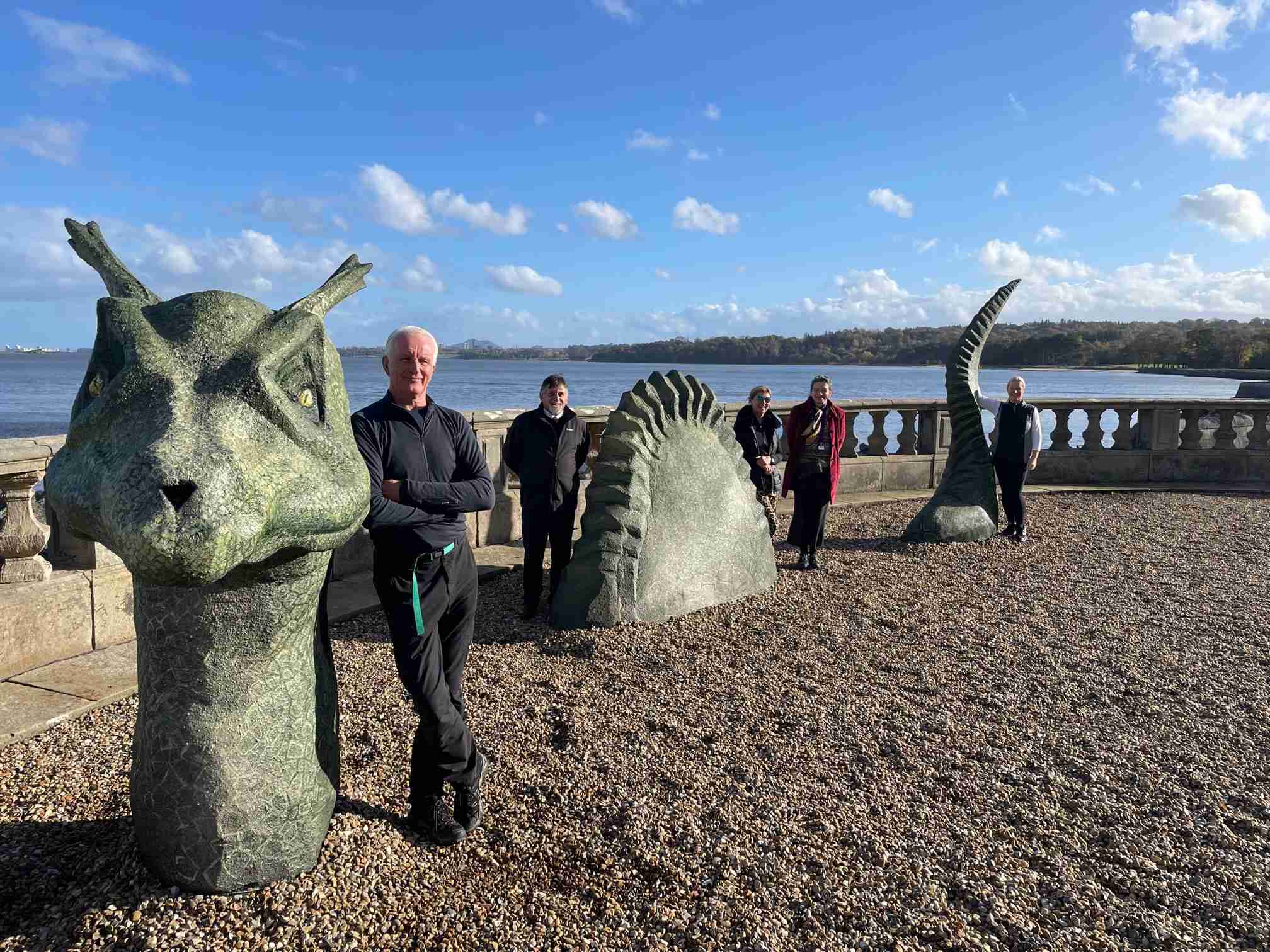News
Largest Search for Loch Ness Monster in 5 Decades Begins

On Saturday, academics and enthusiasts from all over the world descended upon the Scottish Highlands to begin the largest search for the Loch Ness Monster in half a century.
To try and solve a question that has fascinated people for decades, the expedition sent out drones equipped with thermal imaging cameras, boats with infrared cameras, and a hydrophone to explore the depths of the ocean.
Paul Nixon, general manager of the Loch Ness Centre, told reporters, “There isn’t a corner of the globe you can go to where people haven’t heard of Nessie, but it is still one of our biggest questions — what is the Loch Ness Monster.”
I can’t put my finger on it. That there is a large object in Loch Ness is all I know. I’ve seen sonar scans of moving underwater objects the size of transit trucks.
Tatiana Yeboah, a 21-year-old French tourist who happened to be in Loch Ness at the same time as the hunt, said it had always been a goal of hers to see the lake.
To paraphrase Yeboah, “it could be myth, it could be real — I like to believe it is something halfway between,” Yeboah promised she wouldn’t let anything slip by while she was there by promising to keep a close eye on the lake.
The thermal scanners are a potentially game-changing tool, according to the search teams, who are hoping to spot any weird anomalies down there. Using the hydrophone, the team can listen for any strange noises that might be Nessie.
The freshwater loch is the largest lake in the United Kingdom, measuring 36 km in length and reaching a maximum depth of 240 metres.
Stone sculptures in the vicinity depict a mystery beast with flippers, suggesting that stories of a monster lurking in Loch Ness go back millennia.
The first written mention of the beast was in a biography of the Irish monk Saint Columba, written in the year 565 A.D.
Columba supposedly ordered the monster to retreat after it had assaulted a swimmer and was going to strike again.
In May of 1933, a couple driving along a brand-new lochside road reported seeing “a tremendous upheaval” in the water, according to the Inverness Courier.
The Loch Ness Centre in Drumnadrochit, close to Inverness, reports that there have been over 1,100 confirmed sightings of Nessie. Every year, the monster generates millions of pounds in tourist for Scotland.
Both professionals and amateurs have scoured the loch’s depths for years in search of the massive fish, hoping to catch a glimpse of the legendary sturgeon.
Some have hypothesised that the creature is actually a long-extinct marine reptile, perhaps even a plesiosaur. The Loch Ness Investigation Bureau conducted the largest search to that point in 1972, but found nothing.
Operation Deepscan sent sonar equipment over the loch’s width in 1987, claiming to have spotted a “unidentified object of unusual size and strength.”
In 2018, scientists conducted a DNA study of Loch Ness to learn more about the aquatic life there. Results suggested the presence of countless eels, but no huge animals such as plesiosaurs were present.
Nixon elaborated, “The weekend affords an opportunity to search the waters in a manner never before undertaken, and we can’t wait to see what we find.”
Loch Ness Monster dates back to around 565 AD
The Loch Ness Monster, often referred to as “Nessie,” is a legendary creature said to inhabit Loch Ness, a large freshwater lake in the Scottish Highlands. The creature is often described as a large aquatic creature with a long neck and humps that emerge from the water. Reports of Nessie date back centuries, but the legend gained significant attention and popularity in the 20th century.
The first recorded sighting of the Loch Ness Monster dates back to around 565 AD, when Irish missionary St. Columba is said to have encountered a creature in the waters of the loch. However, the modern legend of Nessie gained widespread attention in the 1930s when a series of alleged photographs and eyewitness accounts began to circulate.
The most famous photograph of Nessie, known as the “Surgeon’s Photograph,” was taken in 1934 by Robert Kenneth Wilson. It depicts a long-necked creature rising out of the water. This photograph fueled further interest and speculation about the existence of the Loch Ness Monster.
Over the years, there have been numerous reported sightings, photographs, and even sonar readings that enthusiasts claim provide evidence for the existence of a large unknown creature in Loch Ness. However, most of these pieces of evidence have been controversial and often subject to skepticism and scientific investigation.
Scientists and researchers have conducted various expeditions and studies to search for evidence of the Loch Ness Monster. These efforts have often involved the use of sonar technology, underwater cameras, and other advanced equipment. Despite these efforts, no definitive proof of Nessie’s existence has been found, and many of the sightings and photographs have been debunked as hoaxes or misidentifications of natural phenomena.
The Loch Ness Monster remains a popular and enduring legend, attracting tourists, researchers, and curious individuals from around the world. While there is no scientific evidence to support the existence of a large unidentified creature in Loch Ness, the legend continues to capture the imagination of people interested in mysteries and the unknown.
Keywords: loch ness monster video, loch ness monster story
News
Britain Must Be Ready for War in 3 Years, Warns New Army Chief

The new head of the Army has stated that Britain must be prepared to fight a war within three years.
Gen Sir Roland Walker has issued a warning about a variety of risks in what he calls a “increasingly volatile” environment.
However, he stated that war was not inevitable and that the Army had “just enough time” to prepare to prevent conflict.
He stated that the Army’s fighting capacity would be doubled by 2027 and tripled by the end of the decade.
Gen Walker warned that the Britain was under threat from a “axis of upheaval” in his first speech as Prime Minister on Tuesday.
Among the primary concerns confronting the Britain in the next years, as noted by the general in a briefing, is an enraged Russia, which may seek vengeance on the West for helping Ukraine, regardless of who wins the war.
He stated: “It doesn’t matter how it finishes. I believe Russia will emerge from it weaker objectively – or completely – but still very, very dangerous and seeking some form of retaliation for what we have done to assist Ukraine.”
Britain’s Government Defence Review and Military Challenges
He also warned that China was determined to retake Taiwan, and Iran was likely to seek nuclear weapons.
He stated that the threats they posed may become particularly acute in the next three years, and that these countries had formed a “mutual transactional relationship” since the war in Ukraine, sharing weaponry and technology.
However, he stated that the path to conflict was not “inexorable” if the UK re-established credible land troops to assist its deterrent strategy for avoiding war.
In his speech, he described his force of slightly over 70,000 regular troops as a “medium-sized army” and made no direct call for additional resources or men.
However, he pushed the British Army to adapt swiftly, focussing on technology such as artificial intelligence and weaponry rather than numbers.
His ultimate goal is for the Army to be capable of destroying an opponent three times its size.
This would entail firing quicker and farther, he said, aided by lessons learnt from the Ukraine war.
The general’s speech at the Royal United Services Institute land warfare conference comes only one week after the government began a “root and branch” defence review to “take a fresh look” at the challenges facing the armed services.
Defence Secretary John Healey launched the assessment, describing the existing status of the armed forces as “hollowed-out” and stating that “procurement waste and neglected morale cannot continue”.
According to the most recent Ministry of Defence (MoD) numbers from April 2024, the Britain’s regular Army forces total 75,325 troops (excluding Gurkhas and volunteers).
That figure has been declining in recent years, as recruiting has failed to match retention. The previous Conservative administration lowered the planned headcount from 82,000 to 72,500 by 2025.
Members of the NATO military alliance have agreed to spend at least 2% of GDP on defence by 2024, but several countries are unlikely to fulfil this goal.
The Britain presently spends 2.3% of its GDP on defence. Prime Minister Sir Keir Starmer has previously stated that the defence review will include a “roadmap” for increasing this to 2.5%, however he has yet to provide a date for this promise.
Source: BBC
News
Katie Ledecky Hopes For Clean Races At Paris Olympics In The Aftermath Of The Chinese Doping Scandal

PARIS — Katie Ledecky is looking for clean Olympic races. On Wednesday, Hope had pretty much reached her limit.
The American swimmer hopes to add to her six gold medals as she competes in the 400, 800, and 1,500 meters at the Paris Games. Her program starts with the heavy 400 on Saturday, featuring Ariarne Titmus and Summer McIntosh.

Katie Ledecky | ESPN Image
Katie Ledecky Hopes For Clean Races At Paris Olympics In The Aftermath Of The Chinese Doping Scandal
The 27-year-old Katie is competing in her fourth Summer Olympics, but the first since a doping scandal involving almost two dozen Chinese swimmers who tested positive for a banned chemical before the Tokyo Games — yet were permitted to compete with no consequences. The controversy has raised serious worries regarding the effectiveness of anti-doping initiatives.

Katie Ledecky | Vogue Image
“I hope everyone here is going to be competing clean this week,” Ledecky claimed. “But what truly counts is, were they training cleanly? Hopefully this has been the case. Hopefully, there has been worldwide testing.”
The International Olympic Committee has expressed concern over the ongoing US investigation into possible doping by Chinese swimmers. While awarding the 2034 Winter Olympics to Salt Lake City on Wednesday, the IOC urged Utah officials to do whatever they could to stop the FBI investigation.
“I think everyone’s heard what the athletes think,” Katie added. “They seek transparency. They want more answers to the remaining questions. At this point, we are here to race. We are going to race whoever is in the lane next to us.
“We are not paid to conduct the tests, so we trust those who follow their regulations. That applies both today and in the future.

Katie Ledecky | ESPN Image
Katie Ledecky Hopes For Clean Races At Paris Olympics In The Aftermath Of The Chinese Doping Scandal
SOURCE | AP
News
London Heatwave Alert: High Temperatures Set to Soar to 29C Next Week

As the summer holidays begin, London may experience an official heatwave with temperatures reaching up to 29 degrees Celsius.
The Met Office predicts a long period of sunny and dry weather for London after a soggy spring and summer.
After a cloudy day on Saturday, temperatures are expected to reach 27C on Sunday, with lots of sunlight.
On Monday and Tuesday, temperatures are forecast to peak at 29 degrees Celsius. Monday is forecast to offer more sunlight, while Tuesday may see some gloomy weather.
Temperatures are expected to remain in the high 20s next week, with lows of approximately 18C.
According to the Met Office, a heatwave is “an extended period of hot weather relative to the expected conditions of the area at that time of year, which may be accompanied by high humidity.”
In the United Kingdom, a heatwave is proclaimed when daily temperatures meet or surpass a certain level for at least three consecutive days.
In London, the heatwave threshold is 28 degrees Celsius.
The Met Office reported that the UK is experiencing hotter and wetter weather on average due to climate change.
The UK experienced its warmest May and April on record this year, despite damp and dismal conditions in many areas.
According to the Met Office’s State Of The UK Climate 2023 report published on Thursday, the UK experienced historic levels of extreme weather last year.
In the United Kingdom, 2023 was the second warmest year on record, bringing storms, flooding, strong heatwaves, and rising sea levels; only 2022 was warmer.
It was 0.8°C higher than the average from 1991 to 2020, and 1.66°C higher than the 1961 to 1990 average.
However, 2023 will be a “cool year” in comparison to 2100, based on the planet’s warming trajectory.
The government’s plan to adapt to the hazards presented by climate change is currently being challenged in the High Court by campaigners who allege the Tory administration’s July 2023 National Adaptation Programme (NAP) fails to adequately address 61 concerns.
Source: The Standard
-
World2 weeks ago
Former President Trump Survives Being Shot at Pennsylvania Rally
-
Tech4 weeks ago
Huawei Launches 5G-A Pioneers Program at MWC Shanghai 2024: Paving the Way for a Connected Future
-
Tech4 weeks ago
ChatGPT Answers Undiscovered Questions and Outperforms Students.
-
Sports4 weeks ago
NBA Draft: Kyle Filipowski Withdraws Unexpectedly From The First Round
-
News4 weeks ago
US Supreme Court Rejects Drug Deal that Protects the Sackler Family
-
Health4 weeks ago
US Health Agency Issues Dengue Virus Infection Warning



















